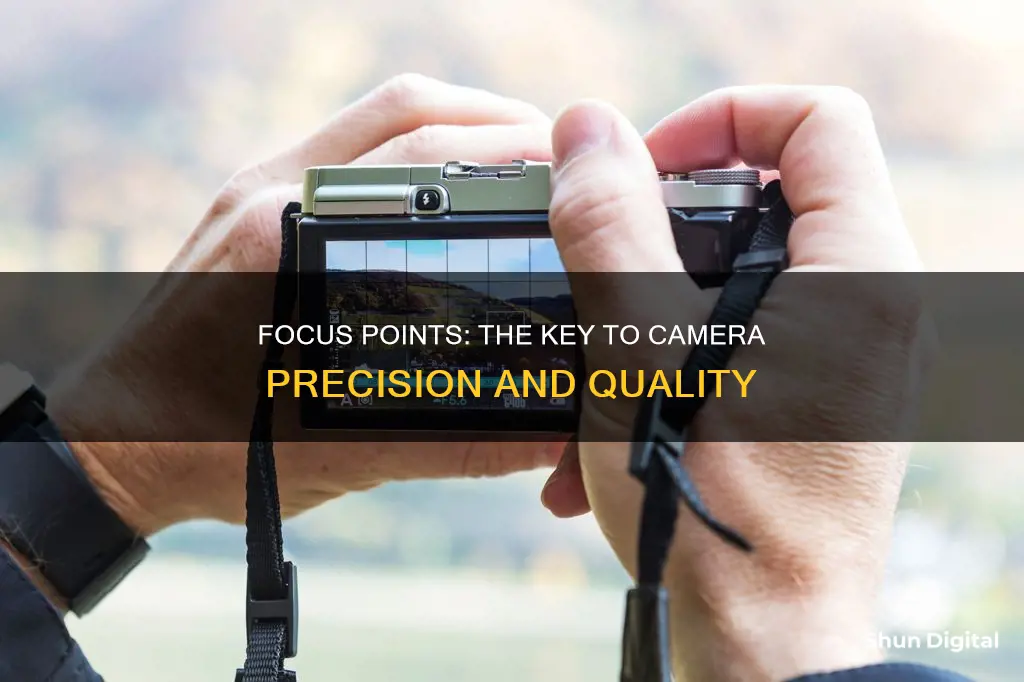
Focus points are an essential aspect of photography, as they determine the sharpness and clarity of an image. They are the dots around the frame that the camera uses to focus, and they can be active or inactive. The number of focus points varies across camera models, with modern systems offering anywhere from a dozen to hundreds of points. More focus points generally enhance the camera's focusing capability, providing photographers with greater control over their images.
Autofocus (AF) points, found in most SLR and DSLR cameras, help photographers direct the camera's focus to a specific area within the frame. This is especially useful when the desired point of focus is not in the centre, where cameras traditionally focus. By allowing photographers to select the focus point, AF points mimic the freedom of manual focus while retaining the speed and ease of autofocus.
| Characteristics | Values |
|---|---|
| Purpose of focus points | To help photographers direct the focus of their photos |
| How they work | Focus points are dots around the frame that the camera uses to focus; they can be active or inactive |
| Number of focus points | Varies by camera model, with modern systems offering from a dozen to hundreds of points |
| Types of focus points | Standard and cross-type (cross-type are more advanced and accurate) |
| Autofocus modes | Single-shot (for still subjects) and continuous/tracking (for moving subjects) |
| AF area modes | Single-point AF, dynamic area AF, and zone AF, each suited for different subjects and conditions |
| Shooting still subjects | Utilise the "focus and recompose" method for precise focusing |
| Shooting moving subjects | Use AF tracking modes to maintain focus on moving subjects |
| Camera focusing | Cameras can either choose the AF point or the photographer can choose it |
What You'll Learn
- Autofocus points allow photographers to focus on composition and lighting
- Autofocus points are a visual representation of what the camera is focusing on
- The more autofocus points, the more finely you can tune your focusing
- Autofocus points can be active or inactive
- Autofocus modes include single-shot and continuous/tracking

Autofocus points allow photographers to focus on composition and lighting
Autofocus points are an incredibly powerful feature of your camera. They allow photographers to focus on composition and lighting by letting them precisely control where the camera will focus. With a wide array of focus points to choose from, photographers have the flexibility to frame their shots exactly as they envision.
Focusing in photography isn't just about clarity; it plays a crucial role in directing the viewer's attention and dictating the mood of a shot. When photographers say "focal point", they usually mean the part of the shot they want to stand out. It could be a single point or several, and the photographer decides where to focus.
The autofocus system intelligently adjusts the camera lens to obtain focus on the subject, and can mean the difference between a sharp photo and a missed opportunity. The inner workings of how a camera focuses are not straightforward. The autofocus sensor(s) are laid out in various arrays across the image's field of view. Each sensor measures relative focus by assessing changes in contrast at its respective point in the image — where maximal contrast is assumed to correspond to maximal sharpness.
The number of autofocus points varies by camera model, with modern systems offering from a dozen to hundreds of points. More focus points generally enhance focusing capability. There are standard and cross-type focus points. Cross-type points are more advanced and accurate.
Autofocus modes include single-shot (for still subjects) and continuous/tracking (for moving subjects). Single-shot autofocus, or AF-S, acquires focus and then locks it. Continuous autofocus, or AF-C, continuously acquires focus, constantly adjusting as the area under the focus point shifts.
Different autofocus area modes instruct the camera on which autofocus points to use and how they should act in concert. Single-point AF area modes allow only one autofocus point to be active at a time. Tracking AF area modes follow the subject around the frame, keeping all autofocus points at the ready and using different points to keep the subject in focus. Auto AF area modes let the camera identify the best point of focus.
Photographers can also manually focus their shots. Manual focus allows for total control over the focus in a photo. It can be time-consuming, especially when precision is required, and it requires a steady hand and a good eye.
Burst Mode: Capturing Fast-Paced Action with Your Camera
You may want to see also

Autofocus points are a visual representation of what the camera is focusing on
When you half-press the shutter button, the camera starts searching for something to focus on. By default, all the autofocus points are active and independently searching for something to focus on. The first autofocus point to "find" something is the one the camera will use, which can often be the wrong point or part of the scene.
In all camera modes more advanced than "Auto", you can select which autofocus points you want the camera to use. You can choose to use all of them, some of them, or just one particular point. For most photography, it is recommended to use only the centre autofocus point. This allows you to point directly at the part of the photo you want to be in focus while you half-press the shutter button.
Charging Multiple Camera Batteries: Efficient Methods to Explore
You may want to see also

The more autofocus points, the more finely you can tune your focusing
Autofocus points are an essential aspect of modern photography, allowing photographers to fine-tune their focus and capture stunning images. The number of autofocus points varies across camera models, with some offering a dozen or so and others boasting hundreds. The more autofocus points a camera has, the more precisely you can control your focusing.
When you buy a camera, you'll often see specifications like "9-point" or "51-point" autofocus systems. These numbers refer to the quantity of autofocus points available, and the higher the number, the more control you have over the final image. With more autofocus points, you can ensure that the camera focuses on exactly what you want, whether it's a person's eye or a specific object in the scene.
The autofocus points are usually visible as empty squares or dots on your camera's viewfinder or LCD screen. When you press the shutter button halfway down, these points come to life, with some blinking or emitting a beep to indicate that they are actively focusing. This is when the camera decides what to focus on, and having more autofocus points gives you greater control over this process.
Different camera models have different autofocus modes, such as single-shot (for still subjects) and continuous/tracking (for moving subjects). Single-shot autofocus, also known as AF-S or One Shot AF, locks the focus on a single point. Continuous autofocus, on the other hand, continuously readjusts the focus, making it ideal for sports or wildlife photography.
By understanding how autofocus points work and how to manually select or activate them, photographers can take full advantage of the technology to create sharp and well-composed images. It's important to note that while autofocus is a powerful tool, it doesn't always get it right, and that's where fine-tuning your autofocus skills and knowledge comes into play.
Camera Battery Drain: Why It Happens and How to Prevent It
You may want to see also

Autofocus points can be active or inactive
Autofocus points are a visual representation of what your camera is focusing on. They are the little dots around the frame that your camera uses to focus. They can be active or inactive. Active autofocus points are used by the camera to acquire focus, while inactive points can be activated by changing AF area modes.
When you buy a camera, you will commonly see specs referring to 9-point or even 51-point AF systems. This describes how many AF points a camera has—the more points, the more finely you can tune your focusing.
By default, all of these focus points are 'active' and independently search for something—anything—to focus on. The first focus point to latch onto something 'wins'. This can often be the wrong point, or at least the wrong part of the right thing.
In all camera modes more advanced than 'Auto', you can select which AF points you want the camera to use (i.e. all of them, just some of them, or only a particular one). You can either have a dedicated AF point selection button or find it in your camera's menu.
It is important to note that a lens can physically only focus at one specific distance at a time. By having all the AF points active, it means you're letting the camera decide which single point to select.
Unleashing Camera Raw's Power: From Basics to Advanced Techniques
You may want to see also

Autofocus modes include single-shot and continuous/tracking
Autofocus modes are an essential aspect of modern photography, allowing photographers to focus on composition and lighting without worrying about focus. The two primary autofocus modes are single-shot and continuous/tracking autofocus, each with its advantages and use cases.
Single-shot autofocus, also known as AF-S, One-Shot AF, or Single-Shot AF, is ideal for stationary subjects. When you press the shutter button halfway, the autofocus mechanism engages, and once it determines that the selected focus points are in focus, it stops, and the lens stays locked at that focal distance. This mode is perfect for portraits, posed shots, macros, and architecture, where there is no need for tracking or covering a wide area.
Continuous/tracking autofocus, on the other hand, is designed for capturing moving subjects. This mode, also known as AF-C, AI Servo, or Continuous AF, continuously adjusts the focus to ensure that the subject within the active AF point remains sharp. As long as the shutter button is partially pressed, the camera will keep working to maintain focus on the subject. This mode is useful for sports, wildlife, and action photography, where subjects are in motion.
While single-shot autofocus is excellent for stationary subjects, continuous/tracking autofocus shines when it comes to capturing moving subjects. However, it's important to note that continuous/tracking autofocus may not always work flawlessly, especially with fast-moving or unpredictable subjects, and can result in some missed shots.
Both autofocus modes have their strengths and applications. By understanding their characteristics and choosing the appropriate mode for the situation, photographers can capture sharp and well-focused images.
Fighting Baltimore Camera Tickets: A Step-by-Step Guide
You may want to see also
Frequently asked questions
Focus points are dots around the frame that your camera uses to focus. They can be active or inactive. Active points acquire focus, while inactive points can be activated by changing AF area modes.
Focus points are important because they allow photographers to direct the focus of their photos to a particular location in the frame. This is especially useful when the main subject of the photo is not in the center, where cameras traditionally focus and meter.
You can either allow the camera to choose the focus point, or you can choose it yourself. If you choose it yourself, you can select a single-point AF area mode, where only one focus point is active at a time, or a tracking AF area mode, which follows your subject around the frame.







